There’s something wonderfully nostalgic about a warm bowl of gluten free tomato soup. Whether you’re sipping it straight from a mug or serving it beside a crunchy grilled cheese sandwich made with gluten free bread, this comfort food classic never fails to soothe.
But here’s the thing: many store-bought tomato soups aren’t actually gluten free. Surprised? You’re not alone. A lot of brands use wheat-based thickeners or are made in facilities with cross-contamination risks, making them unsafe for anyone who avoids gluten.
That’s why we’re diving deep into how to make the best gluten free tomato soup from scratch. In this guide, you’ll find a simple, delicious recipe plus expert tips to make sure every bite is safe, cozy, and full of rich tomato flavor.
Table of Contents
Table of Contents
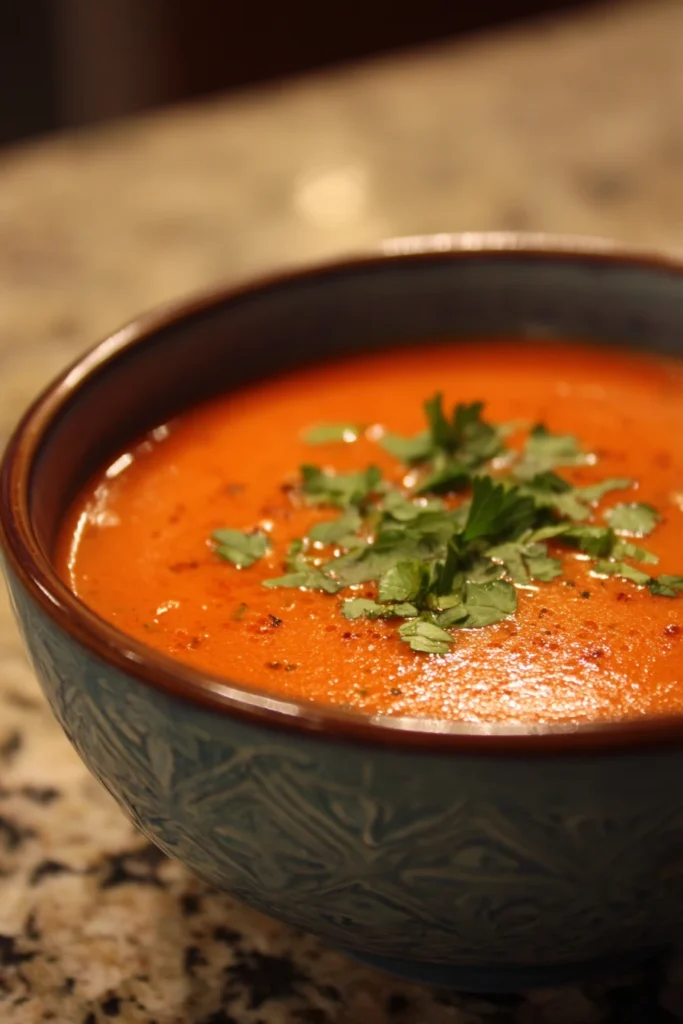
Why This Article Matters
For anyone with celiac disease, gluten intolerance, or even just those following a cleaner diet, finding trustworthy comfort food recipes is tough. Tomato soup may seem like a gluten-free option, but many aren’t.
So instead of scanning endless labels, you’ll learn how to make a thick, creamy gluten free tomato soup right in your kitchen with ingredients you control, love, and can pronounce.
This guide will walk you through:
- Choosing the right tomatoes (fresh or canned?)
- Gluten free ingredient swaps
- Flavor boosters and topping ideas
- Freezing and storage tips
- And a recipe so easy, you’ll memorize it after one try
This Isn’t Just “Gluten Free”, It’s Better
We’re not just stripping away gluten, we’re adding bold flavor, fresh herbs, and creamy texture. You’ll discover how to make a version of tomato soup that’s not just safe, it’s downright craveable.
Plus, we’ll show you gluten-free pairings, variations like dairy-free and low-sodium options, and how to bulk it up into a complete meal.
Related Recipes You’ll Love
Pair your soup with these reader favorites:
- “Looking for more meals like this? Check out our full list of gluten free lunch ideas.
- Delicious Mediterranean Fish Stew Recipe
Both are perfect for quick lunches or weeknight dinners and are completely gluten-free.
What Makes Tomato Soup a Go-To Comfort Food?
You know that feeling when the rain hits the windows, you’re wrapped in a blanket, and something warm is bubbling on the stove? Nine times out of ten, that “something” is tomato soup.
But why does gluten free tomato soup in particular feel so soothing?
It’s more than just nostalgia. This dish has earned its reputation as a year-round comfort classic for a few very real reasons.
A Bowl Full of Memories
Tomato soup is often one of the first “grown-up” soups kids eat. It’s smooth, simple, and full of gentle flavors. No strong spices. No weird textures. Just warmth and a rich tomato base that makes everything feel okay.
Maybe you remember slurping it with grilled cheese on sick days, or dipping crackers into it after school. It’s a memory food, and those kinds of meals stick with us for life.
It’s Quick, Easy, and Budget-Friendly
One of the biggest reasons this soup stands the test of time? It’s just plain simple to make. With only a few ingredients, most of which are pantry staples, you can whip up a satisfying, nourishing dish in under 30 minutes.
And if you’re on a gluten free diet, it’s one of the rare comfort foods that doesn’t have to be totally reinvented. You just need a recipe that doesn’t rely on flour or processed soup bases, and you’re set.
It’s Hug-in-a-Bowl Food
The texture of gluten free tomato soup plays a huge role in why it’s comforting. It’s smooth, warm, and easy to digest, especially when you’re under the weather.
And when made right, it delivers the perfect balance of acidity, sweetness, and savory notes. You get that light tang from the tomatoes, a slight richness from the broth, and maybe even a touch of garlic or basil to round it all out.
When served hot, it creates a kind of calming ritual. You slow down. You breathe in the aroma. You take that first spoonful and everything just softens a little.
There’s Science Behind It
Studies show that warm foods can increase feelings of safety and relaxation. According to research from Harvard’s Nutrition Source, soups rich in antioxidants (like tomato soup) can help reduce inflammation and boost overall well-being.
Tomatoes are naturally high in lycopene, a powerful antioxidant linked to heart health and cancer prevention. And when tomatoes are cooked as they are in soup, that lycopene becomes even easier for your body to absorb.
That means your favorite cozy meal is also delivering some serious health perks.
Source: Harvard Nutrition – Lycopene
More Gluten Free Comforts to Try
If you’re building a collection of soothing, feel-good recipes, you’ll love these two next:
- Comforting Pastina Soup with Egg Classic, gentle, and surprisingly gluten-free when made with the right pasta
- Marry Me Chicken Soup Rich, romantic, and perfect for special nights in
Wrap Up
Tomato soup’s comfort factor isn’t just hype; it’s a mix of sensory joy, tradition, and true nourishment. And when you make a gluten free tomato soup from scratch, you get to keep all of that goodness without the gluten risks.
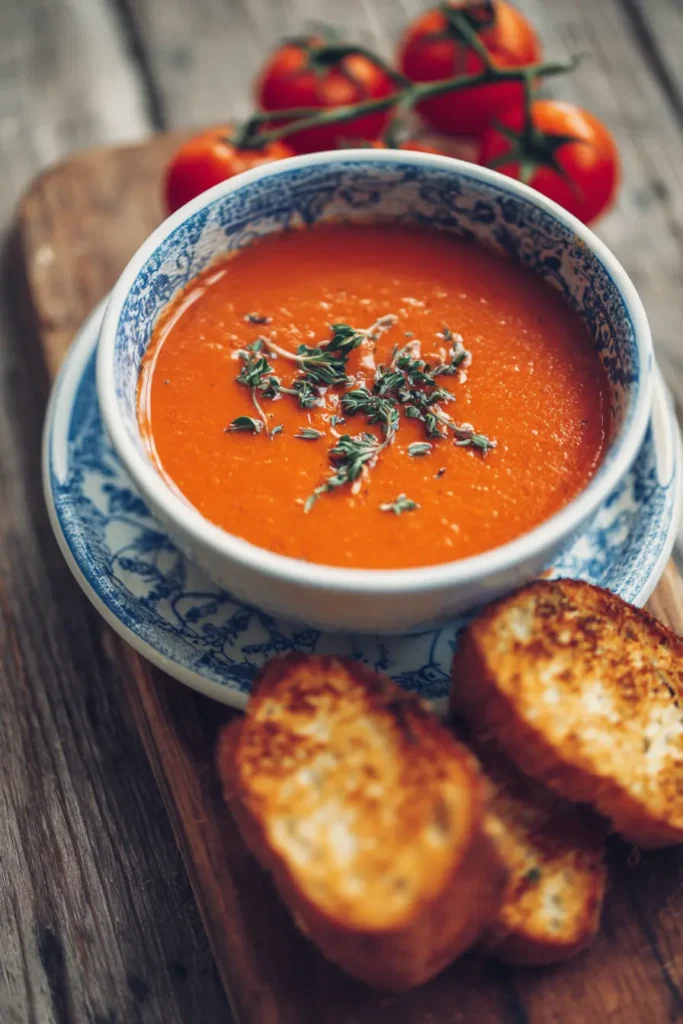
Why Go Gluten Free?
There was a time when the phrase “gluten free” seemed like just another health trend. But today, it’s a way of life for millions. If you’re here looking for the perfect gluten free tomato soup, there’s a good chance you’re already familiar with some of the reasons, but let’s break them down clearly.
This isn’t just about swapping out flour. It’s about protecting your health, feeling your best, and choosing foods that love you back.
What Is Gluten, Really?
Gluten is a protein found in wheat, barley, and rye. It’s what gives bread its stretch, pasta its chew, and sauces their thickness. But for many people, gluten can trigger everything from stomach pain to serious autoimmune reactions.
Who Needs to Avoid Gluten?
There are three main reasons someone might go gluten free:
1. Celiac Disease
This is an autoimmune disorder that causes the body to attack its own small intestine when gluten is eaten. Even a crumb of bread or soup thickened with wheat flour can cause damage. The only treatment? A strict, lifelong gluten free diet.
2. Gluten Sensitivity
Unlike celiac, this doesn’t cause intestinal damage, but it still brings symptoms like bloating, fatigue, headaches, and brain fog. Many people report feeling dramatically better when they cut gluten out.
3. Health and Wellness Lifestyle
Some people go gluten free simply because it helps with digestion, skin clarity, or mental clarity. While research is still developing, many people swear by the benefits of a gluten-free diet even if they don’t have a medical condition.
Want to learn more? The Celiac Disease Foundation has a wealth of information on symptoms, testing, and safe food lists.
How Does This Relate to Soup?
Surprisingly, soup is one of the most common hidden sources of gluten. Here’s why:
Common Gluten Offenders in Soup:
- Roux: Many creamy soups start with a flour-based roux
- Broth or Bouillon Cubes: Some brands use wheat starch as a thickener
- Pasta or Barley: Obvious, but often overlooked in pre-made soups
- Seasonings: Some spice mixes contain gluten fillers
- Cross-Contamination: Shared kitchen tools or factories
Even something as basic as tomato soup can become unsafe if you’re not checking every label.
That’s why homemade gluten free tomato soup is such a game-changer it gives you complete control, from the stock to the spoon.
Benefits of Going Gluten Free
Here’s what many people experience after making the switch:
- Reduced bloating and inflammation
- Better digestion and regularity
- Clearer skin
- Higher energy levels
- Fewer headaches
- Improved mood and mental focus
Of course, results vary, but even if you’re just experimenting with a gluten-free lifestyle, starting with comfort foods like tomato soup makes the journey easier (and tastier).
More Naturally Gluten Free Ideas
Need more inspiration for gut-friendly, feel-good meals?
- Cucumber Beet Salad – Fresh, light, and naturally gluten free
- Easy Sausage Stuffed Acorn Squash – A cozy, hearty fall meal that checks all the boxes
Bottom Line
Going gluten free isn’t just a diet it’s a way to feel good again. And when you make your own gluten free tomato soup, you’re choosing food that nourishes your body, fits your lifestyle, and satisfies your soul.
Hidden Gluten in Store-Bought Tomato Soups
You’d think tomato soup would be one of the safest gluten free options on the shelf. It’s just tomatoes, right? Unfortunately, that’s not the case. Many popular store-bought soups are loaded with hidden gluten, additives, and fillers that aren’t so obvious at first glance.
If you’ve ever bought a can of tomato soup and ended up bloated or uncomfortable afterward, gluten might have been the sneaky culprit.
The Most Common Sources of Hidden Gluten
Here’s where manufacturers like to hide gluten in tomato soups:
1. Wheat Flour as a Thickener
Some brands still use traditional flour to thicken their soup, especially cream-based versions. Always check for “wheat flour”, “enriched flour”, or “modified food starch” (unless labeled gluten free).
2. Barley-Based Ingredients
Barley may show up as malt extract, maltodextrin, or even in “natural flavors.” These ingredients can trigger reactions in anyone sensitive to gluten, even in trace amounts.
3. Stock and Broth Additives
Soup bases, bouillon cubes, and flavor concentrates often contain gluten. Even “vegetable broth” can be a problem if it’s not labeled gluten free.
4. Cross-Contamination
Some soups are technically made without gluten but are processed in facilities that handle wheat. If it doesn’t say certified gluten free, assume it’s not.
How to Read Labels Like a Pro
Here’s a simple checklist to help you shop for gluten free tomato soup with confidence:
| Label Section | What to Look For | What to Avoid |
|---|---|---|
| Ingredients | Tomatoes, water, cream, herbs, spices | Wheat flour, barley, malt, yeast extract |
| Allergen Info | “Gluten Free” or “Certified Gluten Free” | “May contain wheat,” “processed with wheat” |
| Brand Claims | Non-GMO, organic, gluten free certified | “All natural” without gluten mention |
Tip: Always choose brands that display the “Certified Gluten Free” badge and have transparent ingredients.
Trusted Gluten Free Soup Brands
If you’re short on time and need to grab a can from the store, here are some reliable options:
- Pacific Foods Organic Creamy Tomato Soup – Clearly labeled gluten free
- Amy’s Organic Chunky Tomato Bisque – Certified gluten free and vegan
- Imagine Organic Tomato Soup – Great flavor and no questionable thickeners
Still, nothing beats homemade gluten free tomato soup where you control every ingredient.
Real Life Example: The Surprise from “Healthy” Brands
One popular “natural” soup brand adds wheat flour to its tomato bisque yet doesn’t display it on the front label. It’s listed in tiny print under thickeners.
That’s why label-reading is crucial. Just because a product looks clean and healthy doesn’t mean it’s gluten free.
For more label guidance, visit the FDA Gluten-Free Labeling Rule.
Homemade = Peace of Mind
When you make your own gluten free tomato soup, you’re skipping:
- Hidden wheat flours
- Preservatives
- Over-salted broths
- Flavor enhancers like MSG or hydrolyzed protein
Instead, you’re getting bold tomato flavor, pure spices, and healthy fats all while keeping your digestion calm and happy.
Related Recipes for Clean Eating
Round out your weeknight meals with these nourishing dishes:
- Delicious Passover Potato Pie – No gluten, lots of flavor
- Easy Mongolian Ground Beef Noodles – Fast, fun, and gluten free with the right noodles
Wrap-Up
Most canned soups are loaded with sneaky gluten, and you won’t always find it on the front label. That’s why making your own gluten free tomato soup is not only safer but often more delicious and satisfying.
Choosing the Right Tomatoes for Maximum Flavor
If you’re making gluten free tomato soup from scratch, your tomatoes aren’t just an ingredient, they’re the star of the show. The kind you choose will completely shape the flavor, texture, and richness of your soup.
So the big question is: Should you use fresh tomatoes or canned tomatoes? And which varieties give the best result?
Let’s break it down.
Fresh vs. Canned Tomatoes: Which Is Better?
Canned Tomatoes
For most people, canned tomatoes are the go-to choice for homemade tomato soup—and for good reason:
- Consistent flavor year-round
- Already peeled and chopped
- Long shelf life
- Often fire-roasted for added depth
Look for BPA-free cans and low-sodium options. Go with whole peeled San Marzano tomatoes if you want that deep, sweet, almost buttery flavor.
Pro Tip: Crushed or diced tomatoes work in a pinch, but they’re often packed with citric acid and calcium chloride, which can alter texture and taste.
Fresh Tomatoes
Fresh tomatoes bring a brightness and vibrancy you just can’t get from a can if you pick the right kind and they’re in season.
Best fresh varieties for soup:
- Roma (Plum) Tomatoes – Low water, high flavor
- San Marzano – The gold standard in Italy, sweet and full-bodied
- Heirloom Tomatoes – Complex flavor, but more acidic and watery
- Vine-Ripened – Great in summer, but hit or miss the rest of the year
Quick Trick: Blanch and peel fresh tomatoes before using for a smoother soup texture.
Want the Best of Both Worlds?
Use both fresh and canned tomatoes for a layered, dynamic flavor:
- Fresh tomatoes give acidity and brightness
- Canned tomatoes offer deep richness and body
You can even roast fresh tomatoes before blending to add caramelized sweetness to your gluten free tomato soup.
Enhance with Aromatics
Tomatoes need supporting flavors to shine. Always include:
- Garlic – Adds punch
- Onion – Builds the base
- Carrots – Natural sweetness (and no flour needed for thickening!)
- Basil or Thyme – For herby depth
- Olive Oil – Adds richness without dairy
These simple ingredients elevate your soup naturally no gluten, no junk.
Don’t Forget Seasoning
Salt enhances natural tomato sweetness, and a splash of balsamic vinegar or lemon juice balances acidity. Don’t overthink it, taste as you go.
Want creaminess? Add:
- Coconut cream (for dairy free)
- Unsweetened oat milk
- A swirl of full-fat Greek yogurt (gluten free, if tolerated)
Why This Matters for Gluten Free Cooking
When you’re not relying on wheat-based thickeners or artificial flavors, the quality of your base ingredients becomes 10x more important.
Choosing flavorful, high-quality tomatoes is the simplest way to make your gluten free tomato soup taste like a chef made it.
More Recipes Within Our Gluten Free Lunch Collection
If you’re building out your weekly gluten free menu, this soup fits perfectly into our growing recipe group. It’s part of our full Gluten Free Lunch Ideas collection, which features bold, fresh, and balanced meals that are easy on the gut and big on flavor.
You might also enjoy:
- Marry Me Chicken Soup Creamy, herb-forward, and naturally gluten free
Wrap-Up
Don’t settle for bland. Whether you go canned, fresh, or both, the tomatoes you use will make or break your soup. Choose wisely, taste often, and let the natural flavor of real tomatoes carry your dish.
Must-Have Ingredients for a Perfect Gluten Free Tomato Soup
You don’t need a long ingredient list or fancy tools to make a delicious gluten free tomato soup. What you do need is the right combination of quality ingredients that deliver bold flavor without relying on flour, thickeners, or store-bought shortcuts.
This part of the guide breaks down everything you’ll need to create a soup that’s creamy, savory, and 100% gluten free every single time.
Core Ingredients That Make the Magic
1. Tomatoes (Fresh or Canned)
Use high-quality canned tomatoes like San Marzano or fresh Roma/plum tomatoes. For best results, roast or simmer them until soft and sweet.
2. Onion
Yellow onions work great. Sauté until soft for a mellow, slightly sweet flavor base.
3. Garlic
Fresh garlic gives your soup that savory punch. Use 3–4 cloves, or more if you love garlic.
4. Carrots (Secret Sweetness)
Carrots add natural sweetness and act as a thickener. This makes your soup naturally creamy—no flour or starch needed.
5. Olive Oil or Butter
Use olive oil for a dairy-free version or unsalted butter for a richer soup. Both help carry flavor and give the soup a velvety mouthfeel.
6. Salt and Pepper
Always to taste. Tomatoes need salt to bloom.
7. Herbs (Basil, Thyme, Bay Leaf)
Basil adds freshness, thyme adds warmth, and bay leaf gives it a deep, round flavor. Add during simmering, then remove before blending.
Optional (But Recommended) Add-Ins
These take your gluten free tomato soup to the next level:
- Coconut milk – For a dairy-free creamy texture
- Oat milk (unsweetened) – Adds body and creaminess without flavor overload
- Vegetable broth (gluten free) – Always check the label for hidden gluten
- Balsamic vinegar – A splash balances acidity
- Crushed red pepper flakes – For heat
- Parmesan cheese (optional) – Adds umami (ensure it’s gluten free and not anti-caked with wheat starch)
Ingredients to Avoid
Avoid anything that could introduce gluten or artificial taste:
- Flour, roux, or wheat starch
- Pre-made soup bases not labeled gluten free
- Condensed tomato soup cans
- Seasoning packets with “natural flavors”
The goal is simple: real food, zero risk.
Build a Full Lunch with These Recipes
Looking to serve this soup as part of a full meal? These recipes from the same collection fit the gluten free lifestyle and match beautifully in flavor and texture:
- Gluten Free Lunch Ideas – Browse soups, salads, and quick meals perfect for midday
- Cucumber Beet Salad – Fresh and crisp to contrast the warm richness of tomato soup
Ingredient Substitution Chart
| If You Don’t Have | Use Instead |
|---|---|
| Fresh Garlic | 1 tsp garlic powder (gluten free verified) |
| Coconut Milk | Unsweetened oat milk or almond cream |
| Fresh Tomatoes | 1 can (28 oz) of whole peeled tomatoes |
| Onions | Leeks or shallots (chopped fine) |
Final Tip
Remember, the simpler the ingredient list, the more control you have over gluten. Using high-quality whole foods gives you both safety and flavor, no fillers required.
Step-by-Step How to Make Gluten Free Tomato Soup from Scratch
This is your go-to method for making a warm, flavorful, and gut-friendly gluten free tomato soup from scratch. Whether you’re prepping lunch for the week or craving something cozy on a rainy evening, this recipe comes together fast with pantry staples and a few simple tricks.
Let’s walk through the whole process.
What You’ll Need
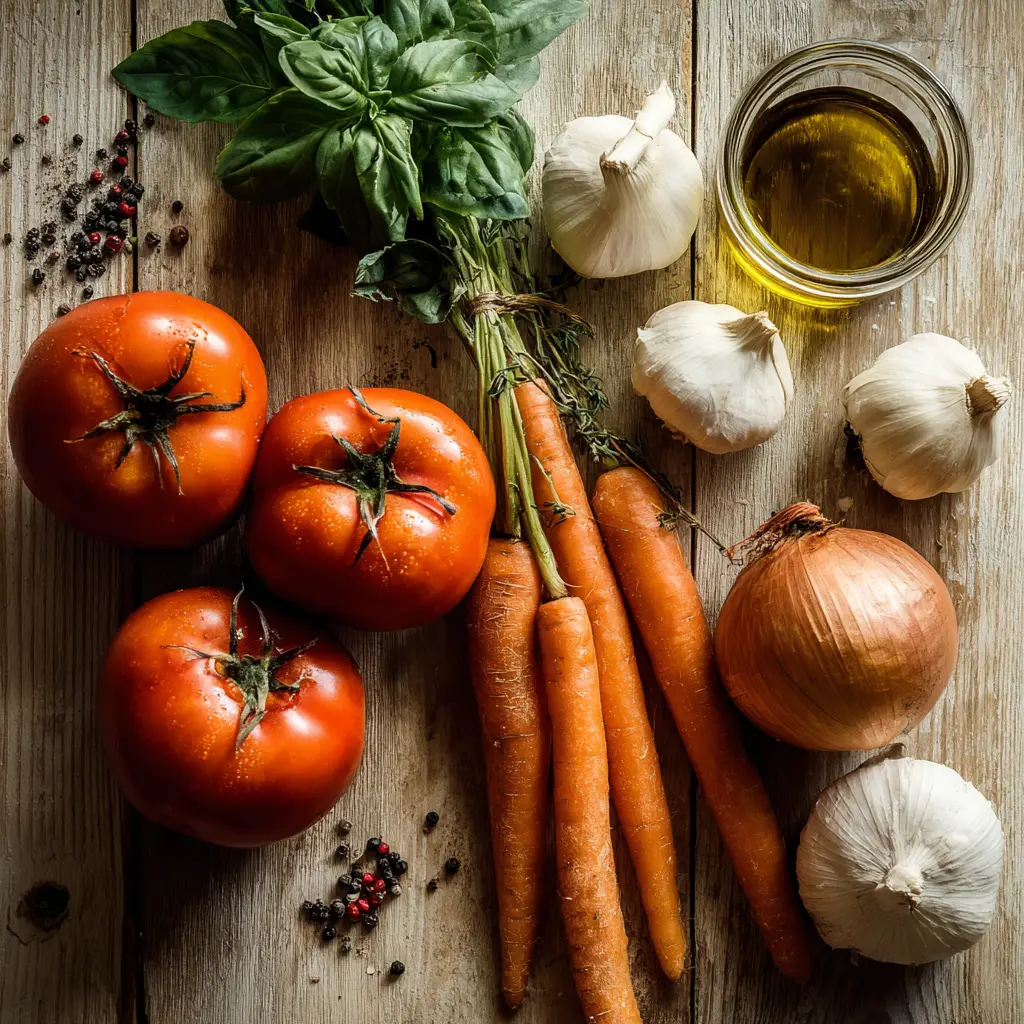
Base Ingredients:
- 2 tbsp olive oil (or unsalted butter)
- 1 medium yellow onion, chopped
- 3 garlic cloves, minced
- 2 medium carrots, chopped
- 1 can (28 oz) San Marzano tomatoes (or 6–7 fresh Roma tomatoes, peeled)
- 2 cups gluten free vegetable broth
- 1 tsp sea salt (adjust to taste)
- ½ tsp black pepper
- 1 tsp dried basil (or 6–8 fresh leaves)
- Optional: pinch of red pepper flakes
To Finish:
- ½ cup full-fat coconut milk (or oat milk, if dairy free)
- 1 tbsp balsamic vinegar or lemon juice (for brightness)
Instructions
Step 1: Sauté Aromatics
Heat olive oil in a large pot over medium heat. Add onions, carrots, and a pinch of salt. Sauté for 6–8 minutes until soft and golden.
Add garlic and stir for 1–2 minutes until fragrant.
Step 2: Add Tomatoes
Pour in the canned tomatoes (with juices). If using whole tomatoes, crush them slightly with a wooden spoon. Add broth, basil, salt, pepper, and red pepper flakes (if using).
Bring to a boil, then reduce heat and simmer uncovered for 25–30 minutes. This allows the flavors to deepen and the soup to thicken naturally—no flour needed.
Step 3: Blend
Use an immersion blender directly in the pot, or carefully transfer the soup in batches to a high-speed blender. Blend until completely smooth.
Note: If you prefer a chunky soup, blend only half and mix back into the pot.
Step 4: Add Creaminess
Return the soup to the pot if blended. Stir in coconut milk and balsamic vinegar. Simmer for 3–5 more minutes, then taste and adjust seasoning.
Step 5: Serve Hot
Ladle into bowls and garnish with:
- Fresh basil
- Drizzle of olive oil or coconut cream
- Cracked black pepper
- Gluten free croutons or roasted chickpeas
How to Store and Reheat
- Fridge: Store in airtight containers for up to 5 days.
- Freezer: Let cool completely, then freeze in glass jars or silicone bags for up to 3 months.
- Reheat: Warm gently on stovetop over low heat, stirring occasionally.
Serve It With These Recipes
Pair this soup with a flavorful side for a well-rounded lunch or dinner:
- Gluten Free Lunch Ideas – Tons of options for pairing with soup
- Delicious Mediterranean Fish Stew Recipe – Tomato-rich and totally gluten free
Taste Tips
- For sweeter soup, add a teaspoon of honey or maple syrup at the end.
- Want extra tang? A dash of apple cider vinegar works wonders.
- Add a teaspoon of smoked paprika for depth and warmth.
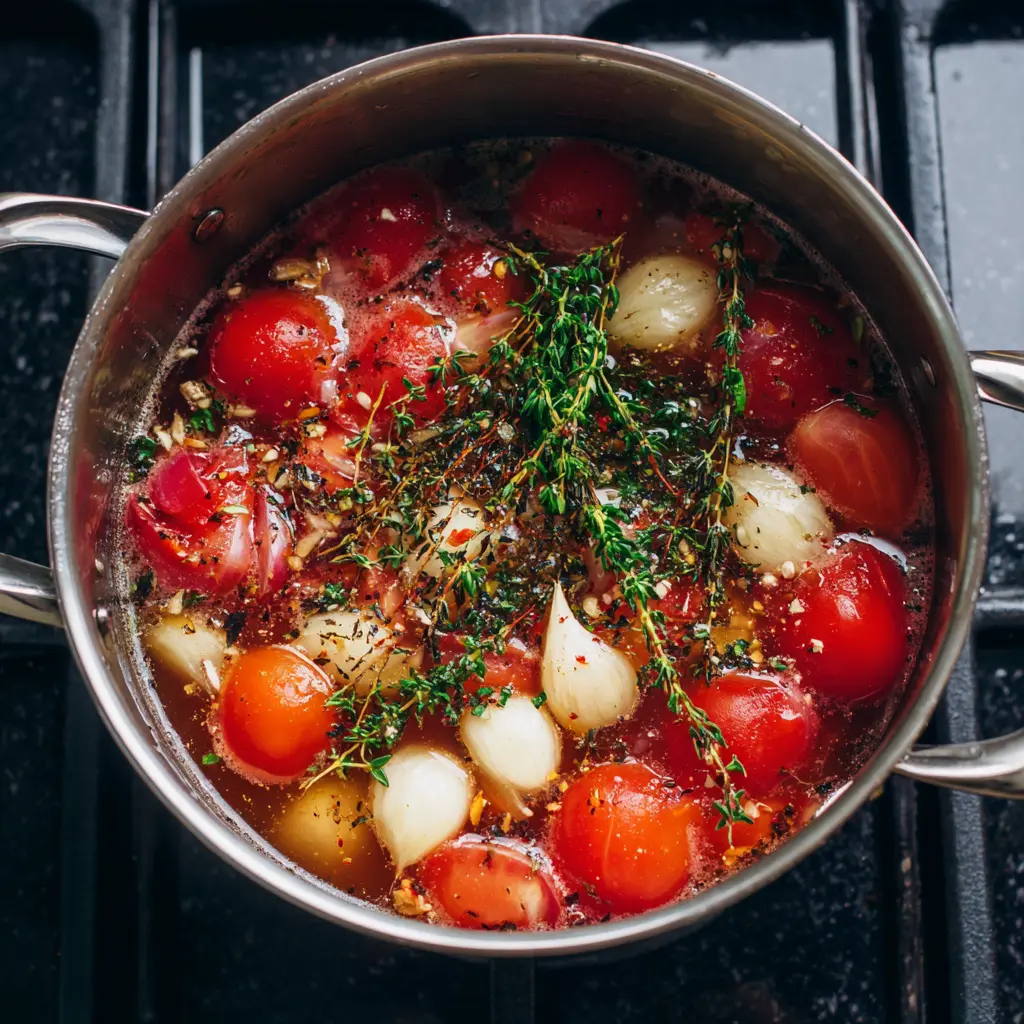
Quick Summary
| Step | What to Do |
|---|---|
| 1 | Sauté onion, garlic, carrots in olive oil |
| 2 | Add tomatoes, broth, and spices, then simmer |
| 3 | Blend until smooth (or leave a little chunky) |
| 4 | Stir in coconut milk and balance with acid |
| 5 | Sauté onion, garlic, and carrots in olive oil |
Final Thought
This recipe proves that gluten free tomato soup can be rich, creamy, and loaded with flavor—no shortcuts, no gluten, no guesswork.
Pro Tips to Take Your Gluten Free Tomato Soup to the Next Level
Now that you’ve mastered the basics, it’s time to elevate your gluten free tomato soup into something extraordinary. These tips are designed to help you customize the flavor, texture, and presentation so it’s not just good, it’s restaurant-worthy.
Even better, they keep everything safe, clean, and gluten free.
Tip #1: Roast Your Tomatoes for Intense Flavor
Whether you’re using fresh or canned tomatoes, roasting them first deepens the sweetness and reduces acidity. Just toss with olive oil, salt, pepper, and roast at 400°F for 25–30 minutes before blending.
Roasted tomatoes = that rich, velvety, “what’s your secret?” taste.
Tip #2: Use Carrots to Thicken, Not Flour
Carrots are a game-changer. They break down naturally when simmered, thicken your soup, and add a subtle sweetness without needing any wheat-based roux or cornstarch.
Gluten free
Flavor booster
Better texture
Tip #3: Let It Rest Before Blending
After simmering, turn off the heat and let the soup sit for 5–10 minutes before blending. This allows flavors to mellow and makes it safer to blend if you’re using a countertop blender.
Tip #4: Sauté Your Spices Early
To amplify flavor, sauté your dried basil, thyme, and garlic with the onions at the beginning. This blooms the spices and helps them coat the veggies in rich oil, making the soup more aromatic and complex.
Tip #5: Finish with Fresh Herbs & Acid
Just before serving, stir in:
- A handful of fresh basil
- A splash of balsamic vinegar or lemon juice
That touch of acid balances the richness and makes the tomatoes pop. It’s a small move that makes a big impact.
Tip #6: Add Crunch with Gluten Free Toppings
Soup doesn’t have to be soft all the way through. Try these crispy toppers:
- Toasted gluten free bread cubes
- Roasted chickpeas
- Grated Parmesan crisps
- Pumpkin seeds
They create texture contrast and give each bite a little surprise.
Tip #7: Double the Batch and Freeze
This soup freezes beautifully. Portion it out in silicone molds or glass containers and freeze up to 3 months. Thaw overnight in the fridge and reheat gently.
Always mark your containers with:
- Date made
- “GF Tomato Soup”
- Serving size (1 cup, 2 cups, etc.)
Tip #8: Always Taste As You Go
Tomatoes vary in sweetness and acidity. Before serving, do a quick flavor check:
- Too tart? Add a pinch of sugar or coconut milk
- Too bland? Add salt and a drizzle of olive oil
- Too thick? Loosen with broth or filtered water
Your taste buds are your best tool.
Recipe Recap: Tools You’ll Want to Bookmark
While you’re building out your gluten free kitchen, explore these:
- Gluten Free Lunch Ideas: More soups, stews, and light meals
- Comforting Pastina Soup with Egg. Another bowl of goodness with simple ingredients
Final Words
This isn’t just a recipe, it’s a skill. With a few pantry staples, fresh ingredients, and these pro tips, your gluten free tomato soup will never be boring again.
It’s not just safe. It’s bold, creamy, and completely crave-worthy.
FAQ: Gluten Free Tomato Soup
1. Is tomato soup naturally gluten free?
Not always. While tomatoes themselves are naturally gluten free, many store-bought tomato soups contain hidden gluten from wheat-based thickeners, bouillon cubes, or cross-contamination. That’s why making your own gluten free tomato soup is the safest and tastiest option.
2. What can I use to thicken tomato soup without flour?
You can thicken it naturally with ingredients like carrots, potatoes, or even coconut cream. Carrots are especially popular in gluten free cooking; they add both sweetness and body without any gluten at all.
3. Can I freeze gluten free tomato soup?
Yes! It freezes beautifully. Just cool the soup completely, portion it into freezer-safe containers, and store for up to 3 months. When reheating, thaw in the fridge overnight and warm gently on the stovetop.
4. What do I serve with gluten free tomato soup?
It pairs perfectly with:
Gluten free grilled cheese
A crisp Cucumber Beet Salad
Roasted vegetables or gluten free garlic bread
For more ideas, check out our Gluten Free Lunch Ideas page.
5. Which canned tomato brands are best for homemade soup?
Look for San Marzano tomatoes, especially certified brands like:
Cento
Muir Glen
Bianco DiNapoli
These offer deep flavor without acidity, ideal for a smooth gluten free tomato soup base.

Gluten Free Tomato Soup
- Total Time: 40 minutes
- Yield: 4 servings
- Diet: Gluten Free
Description
This creamy gluten free tomato soup is rich, flavorful, and perfect for cozy days. Made with clean ingredients and no flour.
Ingredients
2 tbsp olive oil or unsalted butter
1 medium yellow onion, chopped
3 garlic cloves, minced
2 medium carrots, chopped
1 can (28 oz) San Marzano tomatoes (or 6–7 fresh Roma tomatoes, peeled)
2 cups gluten free vegetable broth
1 tsp sea salt
½ tsp black pepper
1 tsp dried basil or 6 fresh leaves
½ cup full-fat coconut milk or oat milk
1 tbsp balsamic vinegar or lemon juice
Instructions
1. Heat olive oil in a large pot. Sauté onion and carrots 6–8 min.
2. Add garlic and stir until fragrant.
3. Add tomatoes, broth, salt, pepper, and basil. Simmer for 25–30 min.
4. Blend until smooth. Return to pot.
5. Stir in coconut milk and balsamic vinegar. Simmer 5 min.
6. Taste, adjust seasoning, and serve hot.
Notes
Use carrots to naturally thicken the soup.
San Marzano tomatoes deliver the best flavor.
Add red pepper flakes for a touch of heat.
Store in fridge up to 5 days or freeze up to 3 months.
- Prep Time: 10 minutes
- Cook Time: 30 minutes
- Category: Soups
- Method: Stovetop
- Cuisine: American

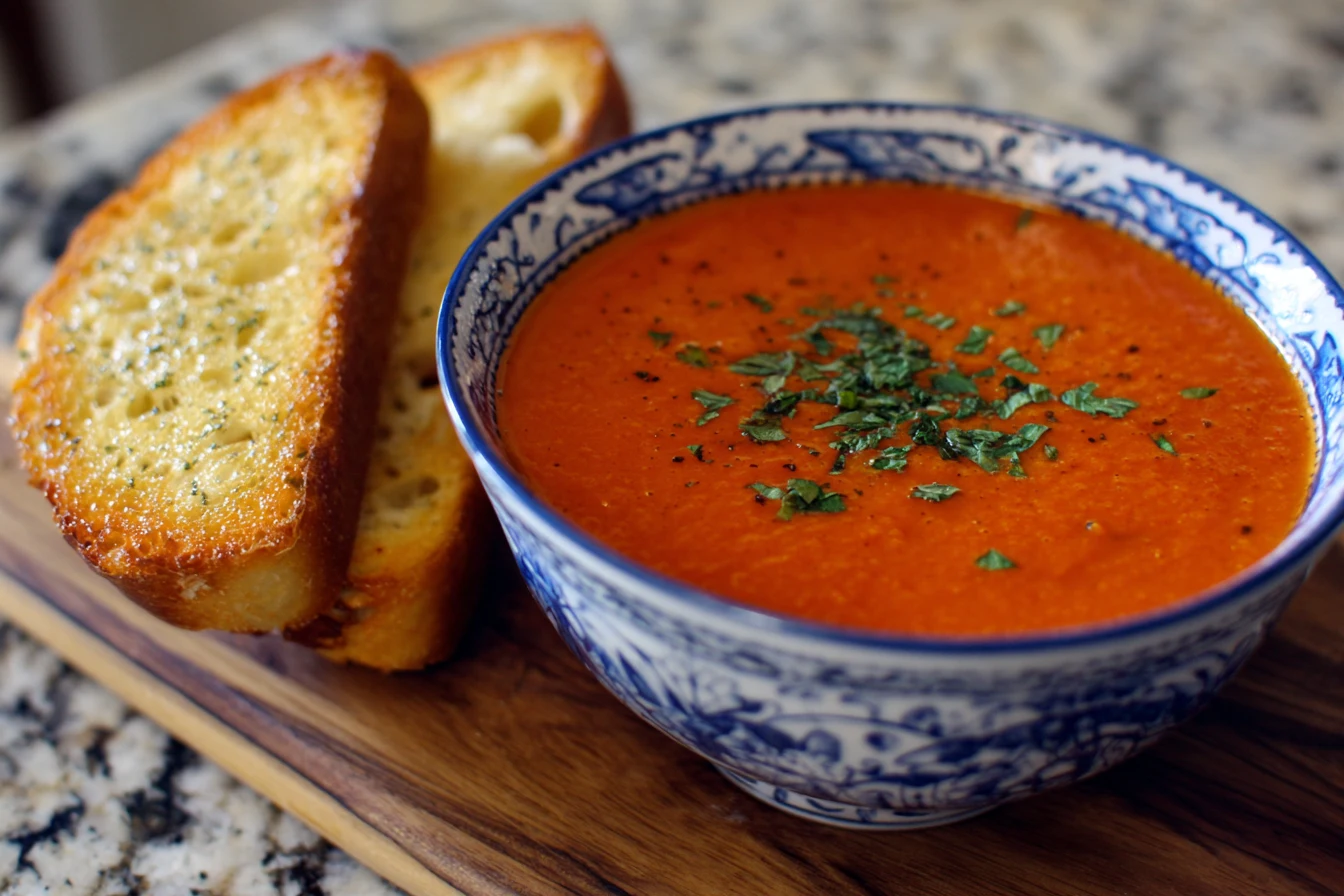



1 thought on “Gluten Free Tomato Soup: The Comforting Classic Made Clean”